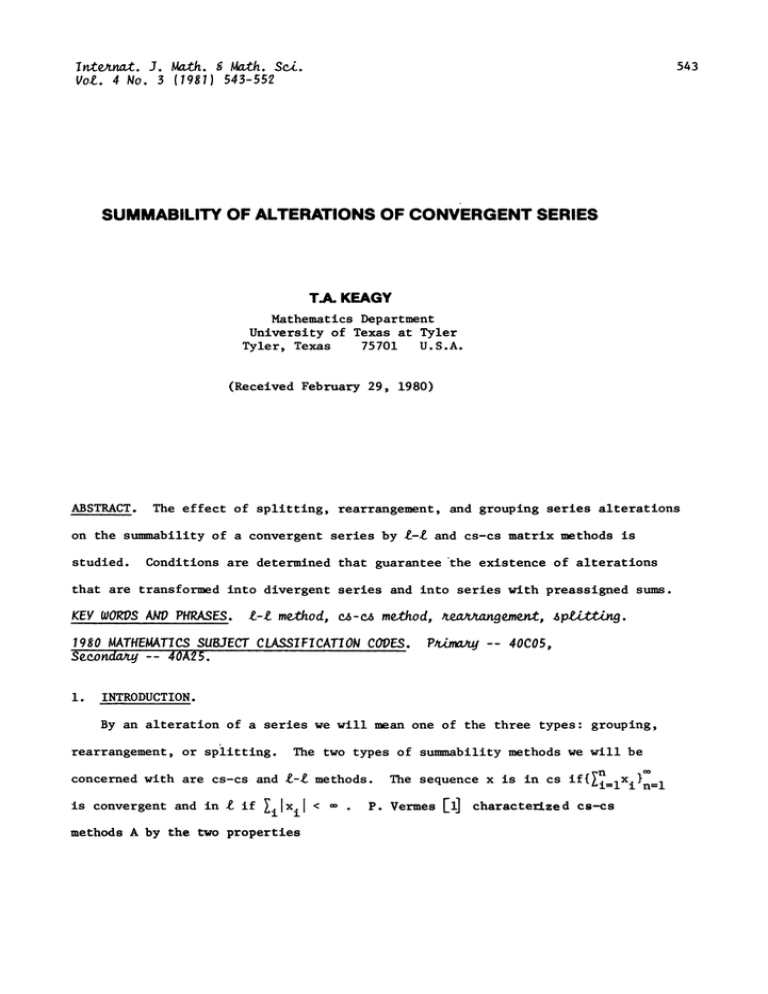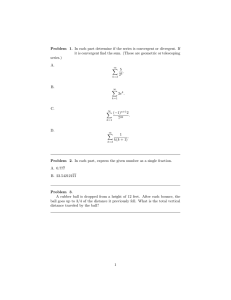SUMMABILITY OF ALTERATIONS OF CONVERGENT SERIES
advertisement

I ntrnat. J. M. Math. Sci.
Vol. 4 No. 3 (1981) 543-552
543
SUMMABILITY OF ALTERATIONS OF CONVERGENT SERIES
TJ KEAGY
Mathematics Department
University of Texas at Tyler
U.S.A.
75701
Tyler, Texas
(Received February 29, 1980)
ABSTRACT.
The effect of splitting, rearrangement, and grouping series alterations
on the sun=nability of a convergent series by
studied.
l-l and cs-cs matrix methods
is
Conditions are determined that guarantee the existence of alterations
that are transformed into divergent series and into series wth preassigned sus.
KEV WORDS AND PHRASES. l-1 mehod, cA-cA mthod, rearrangement, spting.
1980 MATHEMATICS SUBJECT CLASSIFICATION CODES.
Secondary-- 40A25.
i.
P
40C05,
INTRODUCTION.
By an alteration of a series we will mean one of the three types: grouping,
rearrangement, or
splitting.
concerned with are cs-cs and
is convergent and in
I
if
The two types of sumability methods we will be
1-1 methods.
lilxil <
methods A by the two properties
The sequence x is in cs
P. Vermes
[
n
}
if{i=ix
i n=l
characterized cs-cs
544
T.A. KEAGY
apq
(l.1)
converges for each q
and
pq
Knopp and Lorentz
[2
have characterized
-
SUpq.p[apq
p,q-i
methods A by the property
<
Each of the above methods is limit-preserving
P
a
Pq
(1.2)
)
(1.3)
(R).
(qXq .p(AX)p)
whenever
(1.4)
1 for each q.
The main purpose of this paper is to determine what effect alterations of a
convergent series may have on the summability of the series under methods of the
above type.
In 2, we describe each of the alteration types and investigate
properties of the alterations and their respective matrix representations.
-
transformations are determined.
2.
ALTERATIONS OF SERIES.
In
3, alterations of convergent series that map to divergent series by cs-cs or
hat
are mapped by
d-c or
assigned value o.
-
By a grouping alteration
Finally, 4 is concerned with alterations
ransforations
of a series
to series that sum to a pre-
.ixi we will mean a series iYi
determined by an increasing sequence of positive integers
{k(i)}i-i
where the
first term of the altered series is the sum of the first k(1) terms of the
original series, and for i > 1
Yi
Grouping alterations may
b.e
k(i)
LJfk(i-1)+ixj"
entries 0 or 1 that satisfy all requirements for limit-preserving cs-cs and
me thod s.
-
written in matrix form as transformations with all
SUMMABILITY OF ALTERATIONS OF CONVERGENT SERIES
545
Rearrangements are perhaps the most familiar type of series alteration.
They may be represented in matrix form as transformations with all entries 0 or 1
-
which have exactly one nonzero entry in each row and each column.
easily seen to be limlt-preservlng
essarily be cs-cs.
Such maps are
transformations, but they need not nec-
The answer to the question of precisely which rearrangements
preserve the limlt of all convergent series dates at least as far back as 1946
when Levi
[3
first established that a rearrangement p(1), p(2), p(3),
positive integers will always yield a convergent rearranged series
whenever
a
i
of the
ap(k) lai
is convergent if and only if there exists an integer N such that for
each m the set of integers p(1),
...
p(m) can be represented as the union of N
or fewer blocks of consecutive integers.
by
Subsequent proofs of the same result
Guh
here since he utilized (i.i) and (1.2) in his proof, a technique we will use in
the proof of our Theorem 2 later.
Splittings of series were introduced by P. Wuyts
then for each i we write a
a(l,l) +
a(i,1) +
i
+
a(l,kl)
+
a(i,ki).
If
.iai is a series,
The resulting series
+ a(2,k2) +
+ a(2,1) +
is a splitting of the original series.
[6].
(2.1)
In one way a splitting may be thought of
as being the opposite of a grouping alteration since a grouping alteration pro-
duces a new series with sequence of partial sums a subsequence of the original
series sequence of partial sums and a split series produces a supersequence of the
original sequence of partial sums.
The following theorem provides even more
insight into the connection between these wo types of alterations.
THEOREM i.
PROOF.
a2n
x
n
Let
x
i
and
Yi be wo series.
We first determine a splitting
a2n-l
and
a2n+l
Yn+l a2n
There exist a splitting
a x
for n
i
of
i, 2
i
3
by letting a
I
a
YI’
Note that
i
546
T.A. KEAGY
a2n_l + a2n
by letting b
(Xn a2n-l)
for each n.
Xn
a
I
+
and
I
We now determine a grouping alteration
bn+I a2n + a2n+l.
(Yn+l a2n)
Than b
a
I
Yl
I
and
lib i of .iai
bn+I
for n > i, hence the proof is complete.
Yn+l
Representations of spllttings in matrix format presents some difficulty if
If the series does not contain any zero terms,
the series contains zero terms.
(2.1) may be expanded as
al(b(l,l)
+
+
b(l,kl))
+
a2(b(2,1)
+
+
b(2,k2))
+
where
b(i,l) +
for each i.
+ b(i,k i)
(2.2)
i
The splitting may now be represented in matrix form as a series to
series transformation where each row has exactly one nonzero entry.
k
I
entries of the first column will be
through the kI
+
k
2
The first
b(l,kI), and the kI + i
b(l,l),
b(2,1),
entries of the second column will be
b(2,k2).
The remaining columns are formed similarly.
THEOREM 2.
and B is
-
The splitting matrix B is cs-cs if and only if
SUPn,kkn Ib(n, I) +
+ b(n,k)
if and only if
SUPn(lb(n,l)
+ ..-+
-
lb(n,kn)l)
Furthermore, any splitting matrix that is cs-cs or
PROOF.
< =,
< oo.
is also limit-preserving.
The proof follows from straightforward applications of (i.i), (1.2),
(1.3), (1.4), and (2.2) together with the definition of a splitting matrix.
This yields a result reminiscent of, yet distinctly different from, the
following theorem due to
THEOREM. (Wuyts)
.Wuyts
[6].
The split series (2.1) of a convergent series is itself
convergent if and only if
limnmaxkskn la(n,l)
+
+ a(n,k)
O.
547
SUMMABILITY OF ALTERATIONS OF CONVERGENT SERIES
3.
MAPPINGS TO DIVERGENT SERIES.
In
[7]
we provided an affirmative answer to the following question proposed
by J.A. Fridy
[8]:
is a null sequence necessarily in
if there exists a sum-
preserving 4-4 matrix that maps all rearrangements of x into 4?
A similar ques-
if x e cs (4) and A is a limit-preservlng cs-cs (4-4)
tlon is as follows:
matrix, does there exist an alteration of x that A fails to map into cs (4)?
Grouping alterations are always limlt-preserving cs-cs and 4-4 transfor-
mations, therefore it is easy to see that if A is a limit-preserving cs-cs (4-4)
cs (4), then A will map every grouping alteration of x into cs
matrix and x
Rearrangements are also limlt-preserving 4-4 transformations, therefore
follows that A wll map every rearrangement of x
into
Rearrangements are not necessarily cs-cs as noted above.
x
.
Let A be a limit-preserving cs-cs matrix and
cs such that
cs.
Suppose row p of A converges to L
construct a rearrangement y of x such that
qapqyq
the first n terms of y have been determined.
+
x
By (1.2) it is clear that each row of A is of bounded variation and
hence is convergent to some L.
m > n
The following theorem
There exists a rearrangement y of x such that Ay
PROOF.
whenever A is 4-4.
cs and A is cs-cs.
resolves the question in-case x
THEOREM 3.
it
0.
fails to converge.
Let K
i
+
We now
Suppose
ILI(I + maxilxil)
and
i such that
lq__mlapq
a
<
p,q+l
ILl/4K
and
lpt
lapt
L
<
min{q:
x
for t > m.
Choose
n < i < m.
Rearrange the terms of x not included in
sequence {z
i iffim
-Y
xjj
such that
where j
q
is not one of
-xY’
YI’ "’’’ Ym-i
Yi_l }_ for
into a
T.A. KEAGY
548
li.mZl- 2/[L[ + 1
and
Let k > m such that
k
< 2K/11.1.
suPklli.mZt[
k
,lY+/-z+/-l > 2/IL I. Then
epq
Let
Yi
zi
k
l.mz
for m < i < k and continue this building process to obtain a re-
arrangement y of x such that for each N there exist n,m > N such that
[q=napqyq[
> i.
Suppose now that each row of A is null.
of x such that
qy(l,q)
sup
{y(l,J)}-i be a rearrangement
Let
2 and
n
n[.ly(l’q)
< M
3(suPilXi[
+ i).
Let p(1) > 0 such that
](ll)Zqapqy(1,q)
21
<
1/.
Choose q(1) > 0 such that
"q’l
apqy
and
suPk:(1)2MZ;.q(1)+l.i I(apq
Let
Yi
y(l,i) for I <i
J
Let
1
{y(2,J)}J-i
<_ q <_ q(1) + i,
!q(1)" Let Yq(1)+l
rain{i:
x
I
is not one of
ap.q+l)
xj
YI’
< 1/8.
where for q
O, and
SUPnlq.lY(2,)
q(1)
(3.3)
"’’’ Yq }"
be a rearrangement of x such that y(2,q)
qy(2,q)
(3.2)
< M.
yq for
Let p(2) > p(1)
SUMMABILITY OF ALTERATIONS OF CONVERGENT SERIES
549
such that
I(I2) qapqy(2sq)
> q(1) + 1 such
Choose q(2)
< 1/8.
that
q(2)
lE_(,2)7q’i
apqy (2
< 1/8
q)
(3.4)
and
suPk_<p (2)
Let
+
y(2,i) for q(1)
Yi
as in (3.3) for q
2M=q(2)+l [pk= la
1
a
pq
1 < i < q(2) and
Yq(2)+l
supn,mlq=nyq]
qapqyq
and (3.5),
xj
1/16.
where
(3.5)
J
is selected
q(2).
This selection process may be continued for y.
follows that
<
p,q+l
<_ 2M.
Since
SUPn[nq=lyql
< M, it
Therefore by the pattern established by (3.2)
will converge for each p.
It also follows from (3.1) and
(3.4) that the selection process for y may be accomplished so that
p(2n)
p(2n+l)
r"p=l
(Ay) p
(Ay) p
IV"p=l
0, I, 2, 3,
for n
> l
Hence A fails to map y to cs, and the proof is
complete.
Splittings need not be cs-cs or 4- maps.
The following theorem leads to an
answer to the question as to whether a limit-preserving cs-cs (4-4) matrix nec-
essarily maps some splitting of every series x in cs (4) into a series not in
cs (z).
THEOREM 4. Let A,be. a.matrix with an infinite number of nonzero columns,
each one of which is in cs.
If x is a sequence, then there exists a splitting y
of x such that Ay is not null.
PROOF.
Suppose ’A has a row k that is not eventually zero and without loss
of generality assume no element of row k is zero.
follows:
Y3n
Xn.
for n
Clearly
i, 2, 3,
lim___.=l__yn
let
Y3n-2
Define a splitting y of x as
llak,3n-2’ Y3n-I --Y3n-2’
# 0, and Ay fails
to exist.
and
T.A. KEAGY
550
Assume now that A is row finite, and for row p let k(p) be the last nonzero
If row p is a row of all zeros let k(p)
element of row p.
such that k(p(1)) > i.
and
Yl
Let p(2) > p(1) such that
k(p(1)) + i.
and
Let
Yk(p(2))+l
Yk(p(1))-i
0
i/a
Yk(p(1))
k(p(1))+lap(2) ,qYq
Lq= I
Yl 0 for k(p(1)) +
x2 Yk(p(2))"
<
i
p(1) ,k(p(1))
i < i < k(p(2)),
1/2 and k(p(2)) >
I/ap(2),k(p(2))
Yk(p(2))
This selection process for y may be continued so that
each i.
>_
Let p(1)
Yk(p(1))"
Xl
Yk(p(1))+l
Let
0.
l(Ay)p(i)
> 1/2 for
It follows that Ay fails to be null, and the proof is complete.
COROLLARY 5.
If A is a
limit-preserving
cs-cs (E-E) matrix and x
cs (E),
then there exists a splitting y of x such that Ay fails to be in cs ().
4.
MAPPINGS TO
PREASSIGNED .LIMITS.
Rearrangement is the only series alteration method of our three types that
can produce a new series with sum different from that of the original series.
more interesting question is the following:
A
if A is a limit-preserving cs-cs
matrix and o is a preassigned value, under what ,conditions can a convergent
series be altered so that A maps the altered series to one that sums to
o?
The answer for grouping alterations is easy since groupings are limitpreserving cs-cs and E- maps:
the original series.
the alteration exists only when
The same answer applies when A is E-E, x
alteration is rearrangement.
When A is cs-cs, x
cs but x
4
,
is the sum of
,
and the
and the altera-
tion is a rearrangement, the desired alteration will always exist.
The answer for splitings is more complex and in fact depends on the partic-
ular matrix A in question.
If the limit-preserving cs-cs (E-A) matrix is
equivalent to convergence it is clear that A can map a splitting of the original
series to a series with sum s only if u is the sum of the original series.
SUMMABILITY OF ALTERATIONS OF CONVERGENT SERIES
THEOREM 6.
columns {q (i)
551
Let A be a matrix with null rows and an fncreaslng sequence of
}iffil
such that
i for i
i, 2, 3,
and
m{p
If x is any sequence wlth
n
(a
Y.p_p ,q(21-1) ) I}
p,q(21)
n
{If=ix
i}
PROOF.
Let
Yq(1)
bounded and o is any number, then there
i
exists a splitting y of x such that
0
Ay
cs with sum
.
and p(1) > 0 such that if t > p(1), then
t
11 < 2-1
lll.pffilap,q(1)
(4.3)
Using (4.2) and the fact that A has null rows, choose k(1)
that i > i and if k(2)
q(21),
Yk(1)
’
Xl
Yk(2)
q(21
Xl’
and
I) such
Yl
0
otherwise for I < k(2), then
12i=l Vp(1) lap ,k(i)Yk(i)
Lp=l
<
2-2
(4.4)
and
sup
n
I[np=l (ap, k(1)
a
p,k(2) )I <
2-2/(Io-I + ).
(4.5)
Let p(2) > p(1) such that if t > p(2), then
t
-i
<2
-2
(4.6)
and
t
t
l.pflap,k(1)Yk(1) + pflap,k(2)Yk(2)I
< 2
-3
(4.7)
Again using (4.2) and the fact that A has null rows, choose k(3)
q(2i
2
2
k(2) such that if k(4)
q(2i),
Yk(3)
Yi
liffilXi- ’
li=ixi
Yk(4)
i) >
and
0 otherwise for k(2) < i < k(4), then
’4i=37P (2)Iap ,k(i) Yk(i)
"p=l
<
2-3
(4.8)
and
n
SUPn Ip=l(ap,k(3)
a
p,k(4) )I <
2-4 /(I
2
-iffilXi
+ i).
(4.9)
T.A. KEAGY
552
or
This selection process
y may be continued such that the pattern estab-
lished by (43), (4.5), and (4.8) implies that for n > p(1)
I,l.qapqyq
o
< i,
(4.6), (4.7), and (4.9) implies that for n > p(2)
the pattern established by
[p.lqapqYq- [
< 2
-1
and in general for n > p(k)
lp.lqapqYq -I < 21-k"
COROLLARY 7.
A sufficient condition for a llmlt-preserving cs-cs matrix to
be stronger than convergence is that A have null rows and satisfy (4.2).
COROLIARY 8.
satisfying (4.2).
Let A be a limit-preserving cs-cs (-) matrix with null rows
If x
c8
ting y of x such that Ay
() and o is any number, then there exists a split-
cs with sum
limip[ap,q(2i)
.
If instead of (4.2) A satisfies
ap,q(2i_l)
then a splitting y of x exists such that Ay 6
COROLLARY 9.
(4.10)
0,
with sum o.
A sufficient condition for a limit-preserving
-
matrix to
be stronger than convergence is that A have null rows and satisfy (4.10).
REFERENCES
i.
Vermes, P.
2.
Knopp, K.
3.
Levi, F. W.
Series to serie3 transformations and analytic continuation by
matrix methods, American J. Math. 71(1949) 541-562.
and Lorentz, G. G. Beitrage zur absoluten Limitierung,
Arch. Math. 2(1949) 10-16.
Rearrangement of convergent series, Duke Math. J. 13(1946
579-585.
4.
Agnew, R. P. Permutations preserving convergence of series,
Proc. Amer. Math. Soc. 6(1955) 563-564.
5.
Guha, U. C.
6.
On Levi’s theorem on rearrangement of convergent series,
Indian J. Math. 9(1967) 91-93.
Wuyts, P.
On splitting the terms in a convergent series, Simon Stevin
180-188.
11(1949)
7.
Keagy, T. A.
8.
Fridy, J.A.
Matrix transformations and absolute summability,
Pacific J. Math. 63(1976) 411-415.
174(1975)
S,,-,,,_bility of rearrangements of sequences, Math. Z.
187-192.






